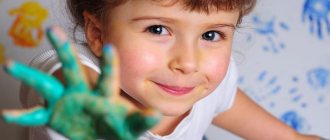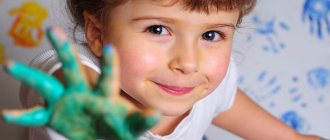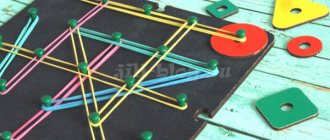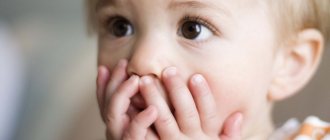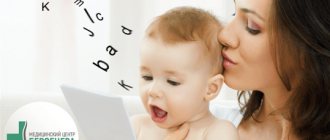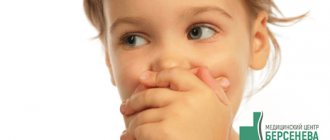This age is called toddlerhood. The period is extremely important in the life of a baby: the growth of the body is not as rapid as in the first year, but the mental and physiological development of the child makes a new qualitative leap.
In the second year of life, the child’s weight increases monthly by 200-250 g, and height by 1 cm. These are average data that can be used as a guide when weighing and measuring the child.
The very proportions of the child’s body also change; If the head size of a newborn child is about ¼ of the total body length, then by the age of 2 years it gradually decreases to 1/5.
The central nervous system becomes noticeably more resilient. The periods of inhibition are reduced, and the periods of active wakefulness of the child increase. Children already know how to concentrate on one activity for quite a long time - up to 10 minutes. The functions of the cerebral cortex are improved, memory develops: the child remembers events that happened several hours ago. Speech improves rapidly and an active vocabulary accumulates.
The activity of the cardiovascular system is noticeably stabilized. It operates with less stress. The heart rate drops to 86-90 beats per minute, which is already approaching the normal readings for an adult.
The musculoskeletal system is improved . There is intensive ossification of soft bone tissue and cartilage. And although this process will continue as long as the person grows (sometimes up to 20-25 years), the skeleton of a child in the second year of life already provides fairly good vertical stability of the entire body. of the muscular-ligamentous apparatus continues . Movements become more confident and varied. But physical fatigue still sets in quickly, the child often changes position, and after considerable effort rests for a long time.
Age-related changes also occur in the gastrointestinal tract . The muscular layer of the stomach wall develops, intestinal tone increases, peristalsis increases, and the nervous regulation of the mechanism of food passage through the intestines improves.
The urinary system functions much more perfectly than in infancy. With relatively small kidney growth, the volume of the bladder increases. Accordingly, the amount of urine excreted once increases, the number of urinations per day decreases up to 10 times. In toddlerhood, the bladder receptors and spinal cord are still underdeveloped - as a result, the urge to urinate is weak. Most children will only be able to respond promptly to a full bladder by the age of 3. Therefore, you should not blame your baby for wet pants.
Like the ability to crawl, walk and talk, the skill of neatness is formed individually for each child. Some children are ready to use the toilet before they reach the age of two, others - only after the third year of life. You can make sure that your child is ready to develop the skill of neatness using the following signs:
- stays dry for an hour or two, sometimes wakes up dry after a nap;
- bladder or bowel movements begin at the same time every day (for example, in the morning or after eating);
- pays attention to the corresponding functions of the body: finds a way to let you know that he is going to “do” something (gets quiet, grunts, goes into a corner, sometimes he can say, somehow “comment” on wet panties);
- experiences a feeling of disgust at the sight of dirty hands, face or aversion to wet diapers;
- begins to feel the difference between wet and dry, dirty and clean;
- knows the specific terminology adopted in the family (“wee-wee”, etc.);
- can communicate needs and follows simple directions;
- shows curiosity about the behavior of other family members (accompanies adults to the toilet and bathroom).
After a year, bowel movements usually occur once a day. The character of the stool changes: it becomes denser, darker in color, with a characteristic unpleasant odor. It is important to ensure that the child does not have constipation; for this you need to strictly adhere to the age-specific diet. If you are prone to this disease, you should consult a doctor. A time-tested way to combat constipation: give your child half a glass of boiled water at room temperature in the morning and offer to use the potty at the same time.
Features of development of children 3 years old (“Munich diagnostics”)
On the one hand, three-year-old children are constantly working motors. They cannot sit still for a long time and quickly change one type of activity to another, since attention at this age is not yet sufficiently developed. On the other hand, 3-year-old children can safely be called conservatives: they like rules, they quickly get used to the daily routine, and preferences in food and games appear. This craving for constancy is explained by the work of basic personality mechanisms that are aimed at ensuring security. What is familiar and predictable to a child causes less fear than what is new and unknown. This age is also notable for the fact that the baby becomes more independent, can defend his interests, stubbornness and whims appear.
To qualitatively assess the psychomotor, speech and communication skills of children, the “Munich Functional Developmental Diagnostics” was created in 1997 in Munich. According to it, at 3 years old a child should be able to do the following:
- Go up and down stairs;
- Jump on one and two legs;
- Catch and kick the ball;
- Do different movements at the same time (for example, shaking your head and clapping your hands);
- Step over obstacles;
- tear paper;
- Sort objects by color, size, shape;
- Build towers from cubes;
- Play games with simple rules;
- Name your gender;
- Orientate yourself in space.
At the age of 3 years, children experience a big leap in physical development. The baby can already run quickly, jump, squat, and turn his body. His movements become more precise and coordinated, and his reaction speed increases. Orientation in space also improves significantly (it is often better developed in boys than in girls of this age).
Features of the body of a three-month-old baby
At 3 months, a baby undergoes significant changes both physically and psychologically. Parents should carefully evaluate the child's condition, provide comprehensive care, and promptly note any age-inappropriate problems.
Physical standards at 3 months
To understand the correct physical changes in a child, you need to monitor the following parameters: height, weight, head circumference and chest circumference. For each baby at three months, these indicators may differ, but on average, according to the World Health Organization, they must meet the following standards: – height: 57-62 cm for girls and 59-64 cm for boys; – weight: 5.2-6.6 kg for girls and 5.7-7.2 kg for boys; – head circumference: 38-41 cm for girls and 39-42 cm for boys; – chest circumference: 37-41 cm for girls and 39-42 cm for boys.
For three-month-old babies, it is normal to gain 700-800 grams in weight and three cm in height over 4 weeks. The circumference of the head and chest increases by 1.5 cm. Anthropometric indicators must be measured monthly.
Small deviations from the specified parameters do not necessarily mean the presence of a disease, but if they are detected, it is better to visit a specialist to make sure that the child is growing normally and harmoniously. You should consult your doctor as soon as possible if the listed indicators differ significantly from the specified standards.
Features of the development of the nervous system of a 3-month-old baby
The nervous system develops especially quickly in the first 3 months of life. By this age, the child, in the absence of any violations, can do the following: – while lying on his stomach, raise and confidently hold his head; – try to roll over onto your stomach; – turn your head to the sides; – when lying on your stomach, lean on your hands and elbows; – clearly fix your gaze on surrounding objects and people; – when holding in an upright position, it is good to lean on your feet; – hum some sounds, hum with different intonations and sound combinations; – respond to sounds, turn your head to their source; - smile.
Unconditioned reflexes are important - automatic movements carried out in response to the action of certain environmental factors. A newborn baby has quite a lot of reflexes, but almost all of them should fade away by three months.
To assess the presence or absence of certain reflexes in a baby, you need to know their manifestations and methods of testing. By 3 months there should be no following reflexes: – proboscis reflex: the child extends his lips with a tube when lightly tapping them; – search reflex: the baby reaches out to the source of irritation if he is tickled on the cheek; – Babkin reflex: the baby opens his mouth when grasping and pressing on the central part of the palm.
The sucking reflex is preserved, and active development of motor skills occurs. Children try to grab toys hanging above the crib with their hands and feel various objects.
Assessment of baby's muscle tone at three months
Newborns are characterized by a state of physiological hypertonicity of the flexor muscles, that is, the baby’s arms and legs extend harder than they bend. By 3 months the tone is evened out. Problems with muscle tension at 3 months of age are quite common, so you need to know the normal criteria. To check the muscle tone of a baby at three months, you need to undress and place him on his stomach on a hard surface. Evaluation criteria: – a 3-month-old child holds his head elevated for several minutes and turns it from side to side; – the baby’s hands rest on the forearms; – the chest is slightly raised above the surface, and the stomach and pelvis are tightly pressed to it; – the child’s hips are slightly apart and the shins are raised; – when mentally drawing a line from the back of the head to the lower gluteal fold, the result should be straight (if there are violations, this line is beveled to the side); – when bending and extending the legs, the gluteal and popliteal folds should be symmetrical, while the movements themselves are performed freely, and the pelvis does not come off the surface. With the baby on his back, the head should lie on the center line and turn in different directions without difficulty. The child holds his hands freely, constantly plays with them, and puts them in his mouth. The right and left sides of the body should be symmetrical to each other.
Development of fine motor skills in children 3 years old
- Drawing. At 3 years of age, drawing development is at the scribble stage. Despite the fact that the drawings can sometimes turn out to be shapeless, the child puts his own meaning into them. Three-year-olds with well-developed fine motor skills can already draw simple shapes (circle, square, lines). The drawing of a person in 3-year-old children turns out to be primitive, but it already contains a head, body, legs and arms.
- Ability to unfasten zippers and buttons. Although a 3-year-old child still cannot fasten a button or zipper himself, he has already learned how to unfasten them. Encourage your child's desire for independence, because fastening and unfastening various clasps not only perfectly develops fine motor skills, but also stimulates the development of thinking.
A three-year-old child has most hygiene skills. He knows how to wash himself, wash his hands, go to the potty, undress, and tries to eat carefully at the table.
- Toys that require developed finger motor skills. Usually at this age children like to play with small objects; puzzles, construction sets, lacing, and mosaics are used. When giving your child such toys, do not forget about safety precautions and do not leave the child unattended while playing.
- Finger games. Finger gymnastics can be a fun exercise for developing your baby’s fine motor skills. You can find ideas for finger games in the video:
Osteopathic appointment at the Quality of Life clinic
Young children are a special group of patients who require a careful approach in order for the appointment to be successful. The Quality of Life clinic employs experienced pediatric osteopathic specialists, exercise therapy and related areas, who provide comfort not only to parents, but also to the youngest patients themselves. All diagnostic and therapeutic procedures are carried out carefully and as painlessly as possible. To protect the baby from negative emotions, especially when he is hyperexcitable and tearful, experts agree to the following: – conduct the reception not in a white coat, but in colored clothes that distract and do not frighten the children; – do not lay the baby down and refuse to completely undress him; – use distractions, in particular toys. Doctors take a comprehensive approach to examining and treating patients of any age. Specialists conduct accurate diagnostics aimed at identifying the cause of the disease or risk factors for its occurrence. Only after a full examination does the doctor prescribe a set of therapeutic or preventive measures.
Development of thinking at 3 years old
The famous psychologist J. Piaget believed that the thinking of three-year-old children is structured in such a way that they cannot look at the situation from the outside. This phenomenon is called egocentrism of thinking. In addition, children at 3 years old are not yet able to fully understand the connections between events or phenomena, so there is little logic and a lot of imagination in the child’s thinking.
It is at this age that a very important transition occurs from visual-effective to visual-figurative thinking. If in early childhood a child learned about the world through actions with objects, feeling them, tasting them, now, on the threshold of preschool age, children usually acquire the ability to act with images of objects that are preserved in their memory. A child of three years old can think about something that is not within sight. This is an extremely important step towards logical thinking.
Pediatric osteopathy
Osteopathic interventions in early childhood are carried out not only to treat diseases, but also to prevent their occurrence. Babies at 3 months of age respond well to osteopathic influence, since their body is not yet fully formed. Therefore, visiting a doctor of such a profile will not be superfluous, even if the baby’s health is completely normal.
The main advantages of visiting an osteopathic clinic: – Osteopathic doctors perceive the baby’s body as a single system and have a comprehensive effect on it. – Osteopathy is used without the use of medications or surgical interventions, so it can be performed even on such young children. – The clinic’s doctors do not fight the symptoms or even the mechanisms of formation of the disease, but identify its exact cause. This allows in many cases to achieve complete restoration of health and eliminate various complications. – Pediatric osteopathy can effectively prevent the occurrence of any health problems for the baby, even in the presence of risk factors. It would be optimal to show the baby to a specialist during the neonatal period, so that he can immediately assess the condition of the body, identify or exclude all kinds of predisposing factors, give recommendations and, if necessary, prescribe procedures. – Osteopathy is completely safe for babies. All pediatric specialists are full-fledged doctors with higher medical education who have undergone additional training at a specialized osteopathic school. Osteopathic treatment is not a panacea for all diseases. Pediatric osteopaths carefully evaluate each situation, determining indications and contraindications for the use of specific techniques. An integrated approach is considered the most effective. To achieve better results, osteopathic techniques can be combined with exercise therapy, massage, gymnastic exercises and medications if necessary.
Can three-year-olds be attentive?
The ability to concentrate in 3-year-old children is low, which is why they quickly switch from one thing to another. If you force your baby to do the same thing for a long time, that is, more than 10 minutes, the nervous system will be overloaded (an external sign of which is hysterics). The attention of 3-year-old children is selective; they pay attention only to what is attractive to them.
When working with your child at home, pay attention to the baby’s condition. At this age, children get tired quickly. Therefore, all classes should be held in a relaxed playful manner. To see how you can interest a child, watch the video.
Reasons for silence
In the modern world, most children begin to speak much later. But not all parents know about this, so they immediately begin to look for reasons in the baby.
The causes of speech delay can be social and biological.
Social causes can be eliminated on your own; if biological causes are detected, you should consult a doctor.
Social
Tense family relationships. The speech apparatus is not developed in children whose parents have little communication both with each other and with their “silent one.” To eliminate the problem, you need to reconsider the relationship in the family, especially between mom and dad. As a rule, when various descriptions, actions, and emotions are added to speech, the baby begins to repeat after adults and speak.
Frequent colds in children. If the baby is sick a lot and is isolated from other children, disturbances in his speech will be noticeable. Parents of such a child should allow him to explore the environment and people around him so that speech is restored as soon as possible.
Rough treatment of a child. If constant physical or psychological abuse occurs at home, then not only speech, but also the entire health of the baby as a whole will suffer.
Pedagogical neglect . Many parents mistakenly believe that their child is smart and capable from birth and that developing skills does not require effort. But that's not true. Other mothers and fathers shift responsibility to teachers in kindergarten and teachers at school. They forget that it is the family that lays down the child’s abilities.
Lots of language learning. Often, due to the desire to learn several foreign languages, a parent forgets to pay due attention to Russian literacy and speech.
Emotional stress. The reason for the lack of speech data in a baby may be an event that caused negative emotions, fears, or emotional disorders . In this case, you should seek help from a psychologist or speech therapist.
Excessive control. Parents often forget that they need to develop independence in their children. Moms, trying to protect their child from negativity, only make things worse for him. Indeed, due to overprotection, there may be a slowdown in overall development, and, in particular, speech.
Loaded information environment. If there is too much information around the baby, for example, a computer, TV, radio, telephone, he very quickly becomes isolated and withdraws from the world around him.
Biological
Heredity . As a rule, children pronounce their first words at the same age as their parents. If mom or dad started talking late, then the baby will also be slightly behind in development. There is no need to worry about this, because this is not a pathology, but just a hereditary factor.
Hearing loss. In the modern world, a large number of children are born with hearing loss or hearing loss. Such kids need more attentive attention to improve the development of speech abilities.
Consequences of diseases. Speech problems may be due to a previous illness or congenital injury.
Viral disease of the mother during pregnancy or lactation. Medicinal, chemical or narcotic substances in the mother's blood can negatively affect the development of the child.
Development of memory and imagination in children 3 years old
Children of this age have the best developed emotional memory. A 3-year-old child remembers well what evokes vivid emotions and impressions in him. It's no secret that preschool children have very developed imaginations. Most of the time, three-year-old children are in the world of their fantasies. However, this also has a negative side; children can be very impressionable, which is why many fears arise that are characteristic of preschool age (fear of the dark, dogs, thunderstorms, etc.).
Psycho-emotional development
Psycho-emotional development is the most important element in the process of personality development. It is worth paying special attention to the child’s internal state, his feelings and emotions, the climate in the family and the child’s interaction with his loved ones. The model of self-awareness, behavior in society, building one’s own family, and relationships with the opposite sex are formed in preschool age.
By 3-4 years old, the child:
- Identifies himself by gender.
- Expresses his feelings (“I’m angry”, “I’m upset”, “I feel unpleasant”).
- Developed empathy, understands if he hurts or offends someone.
- Evaluates his own and other people’s behavior (Misha hit Katya, he acted badly).
- Realizes that all actions have consequences.
- Has personal boundaries, including regarding tactile contacts (does not allow strangers to touch or hug him).
- Recognizes the value of things (“It’s okay if you broke your machine, but if you throw it away and it’s broken, it won’t work anymore”).
- Open to new activities and experiences.
- They developed their own interests and preferences (dinosaurs or cars, dancing or singing).
- Taste regarding clothing and creativity is formed.
- Elementary cause-and-effect relationships have been formed (if you lick salt, it will be salty, if you push a vase, it will fall)
Mental development of children at 3 years old
By the age of 3, children usually have many new skills and abilities in the field of mental abilities. A three-year-old child should be able to:
- Compare and sort objects by size, length, shape, color;
- Find the same object;
- Compose puzzles from 4 parts;
- Name primary colors and shades;
- Know poems and songs;
- Make up a story based on a familiar picture with the help of an adult;
- Know the names of some trees, dishes, furniture, animals, clothes, transport, vegetables and fruits;
- Know basic geometric shapes;
- Tell him what he did during the day.
Speech development in three-year-old children
The speech of 3-year-old children is actively developing, kids develop an interest in language, they love to chat and talk about everything they see. Here are the main directions of speech development of three-year-old children.
- Enrichment of vocabulary;
- Phrasal speech;
- Ability to conduct dialogue (the child knows how to ask and answer questions);
- The appearance of polite words.
The speech itself of a three-year-old is far from perfect. Babies at this age usually have difficulty pronouncing hissing and sonorant sounds. At 3 years old, children often spell sentences incorrectly, confuse words, and miss words.
Adaptation in kindergarten
Most often in our country, it is at the age of 3 that a child receives a ticket to kindergarten. Regardless of the character and temperament of the child, adaptation occurs for everyone.
Here are some tips to help you and your child get through this period as smoothly as possible:
- Take some time to get used to it. The best option is 3-4 weeks part-time. Even if the teachers advise you to leave the child and go away, do not agree. Find an opportunity to be with him, do not leave him alone during such a difficult period. If your baby plays with children and doesn’t need you, then just watch him from the side.
- Try to create a comfortable environment in the garden and at home. Allow you to take your baby's favorite toy into the group if he asks for it.
- It is important that at home the child is given the opportunity to switch. During adaptation to kindergarten, you cannot demand that he be an angel at home. The baby gets very tired psychologically. Let him just lie at home if he wants. Or, on the contrary, he makes noise, screams and runs. He needs to learn to compensate and balance the mental load.
- Do not burden your baby with additional sections and circles. First, let him get used to one thing.
- The child needs your support. Outside the garden, give it all of yourself: chat, play, read, walk. Put down your phone and computer and spend time together.
- Talk to your child. Ask questions, find out the names of your child’s teachers and friends. Take an interest in your child's kindergarten life.
- If just a few months ago a baby was born in the family, do not send your older child to kindergarten. Having a younger brother or sister is already stressful, don't add additional stress.
- Make friends with teachers. Ask them about how your baby behaves in kindergarten and how his peers treat him.
Photo source: shutterstock.com
Communication skills
If your child used to play alone, now the company of his peers is important to him. Children at 3 years old are usually very sociable and outgoing. According to the classification of M.I. Lisina for this age is characterized by an extra-situational-cognitive form of communication. This means that communication most often occurs against the backdrop of joint activities to get to know the world. At the same time, it is very important for a 3-year-old child to feel approval and sympathy from loved ones.
Characteristic features of infancy
Ages up to one year, but after the neonatal period, are characterized by their own characteristics, which are also applicable to three-month-old babies: – intensive growth rate; – intensive functional and anatomical changes in all organs and systems; – close and frequent contact with the mother through breastfeeding; – intensive metabolism to ensure high growth rates, due to which the need for energy and, accordingly, the consumption of nutrients is increased (a baby requires 3 times more energy than the average adult); – active development and improvement of the nervous system; – gradual loss of transplacental (transmitted from the mother) immunity with a rather slow formation of its own protection (however, due to the lack of close contact with other children, the likelihood of infectious diseases does not increase).
The growth rate and rate of development of a child is partly programmed genetically. However, the role of environmental factors cannot be excluded. Proper care for an infant not only helps reduce the risk of developing any health problems, but is also an important factor in the child’s adequate growth.
conclusions
By the age of 3, a child develops many new skills and abilities. The baby becomes more and more independent, he gradually learns to take care of himself. A three-year-old child controls his body quite well; he can maintain balance, run, jump, and play ball. The baby’s cognitive abilities also improve: thinking becomes imaginative, memory, attention, speech, and imagination develop. Communication with people reaches a new level, children become interested in communicating with peers.
Speech development
Speech development in preschool age is most relevant. Its main goal is to develop free communication with peers and adults, obtain information, and build social connections.
By 3-4 years old, the child:
- Makes proposals.
- Answers questions and follows age-appropriate requests and instructions.
- Tells about events and impressions of the day.
- Tells the story in the first person, using the word “I”.
- Tries to use correct case endings.
- Describes what is shown in a painting or illustration.
- Knows his name and age.
- Knows the names of parents and loved ones.
- Reproduces complex sentences, lines from songs and poems spoken by adults.
- Knows songs and poems that he often heard.
- Changes voice volume at the request of an adult.
- Actively communicates with familiar people, but experiences discomfort and embarrassment when communicating with strangers.
- Listens to his own speech, tries to correct mistakes himself or at the request of adults.
- Encourages adults to play role-playing games with him, distributes roles.
- Word creation.
